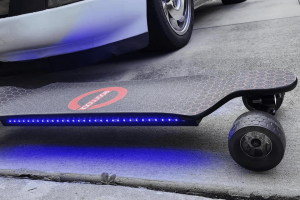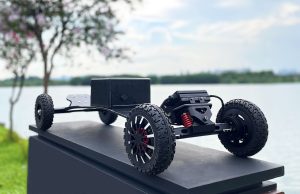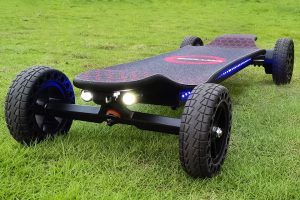Skateboarding, a sport etched into the heart of urban life, has embraced technology’s steady hand, giving birth to the electric skateboard. But today, we ask an unconventional question – can this technological offshoot retreat to its analog roots? Can an electric skateboard transform back into a regular skateboard simply by removing the motor? The short answer is yes but with a few important caveats.

As we delve deeper into the transformation process, prepare yourself for an exciting exploration that intertwines mechanics, the physics of skateboarding, and real-life practicalities. Join us as we deconstruct, experiment, and rediscover the joy of skateboarding in its simplest form. Are you ready to kick-push your way through this captivating journey? Let’s roll!
The Structure of Both Electric and Regular Skateboards
A regular skateboard and an electric skateboard, although closely related in terms of their basic structure and purpose, diverge fundamentally when we delve into the particulars of their design.
When you think of a regular skateboard, it’s all about simplicity and manual operation. Composed primarily of a deck, trucks, wheels, and bearings, it’s a minimalist piece of sports equipment that relies entirely on the user’s body movement for propulsion. The art of balance, momentum control, and intricate footwork paints the picture of a skater’s life.
In contrast, an electric skateboard introduces complexity to this classic setup. At its essence, an electric skateboard retains the fundamental components of a regular one but takes a gigantic leap technologically. It incorporates a motor – the heart of the electric skateboard. This power unit, governed by a wireless handheld controller, dictates the board’s speed and direction. Completing the high-tech transformation is a sophisticated battery management system nestled within the board’s structure, providing the necessary energy for your electric ride.
Adding a motor and battery drastically sets an electric skateboard apart from its conventional counterpart. The rider can traverse greater distances effortlessly at quicker speeds, stirring an exciting dialogue between traditional skateboarding practice and modern convenience. As we further dissect these two, remember that each version of this fantastic sports equipment is a product of its times, embracing the skateboarder’s evolving relationship with technology and motion.
The Process & Challenges of Removing the Motor

Transforming an electric skateboard to traditional skateboard involves a critical operation – bidding adieu to the motor. The process can quite literally be electrifying, rife with challenges, but by following careful steps and safety procedures, our keyword star, the electric skateboard, can successfully mute its technological buzz.
Step one is gaining access to the motor. Typically, it’s found snugly situated next to the battery compartment, tucked away under the deck. Before reaching out for any tool, ensure your electric skateboard is switched off and disconnected from all power sources as a safety measure. Now, unscrew the protective casing to reveal the motor, a crucial organ of this electromechanical system.
Next, proceed to disconnect the motor. This usually involves unplugging wire connections that tie it to the controller and the battery. Always remember to keep track of which wire connects where; you don’t want to create a jigsaw puzzle for yourself should re-installation be needed!
However, it’s not all smooth sailing. Challenges lie in potential void warranties and loss of functionality. Dismantling a motor is intricate work–one erroneous move could permanently damage the board. Also, the space left vacant by the motor might interfere with the seamless design of a skateboard, promoting discomfort during use.
Similar to a seasoned surgeon’s meticulous approach, the transformation process demands precision, a comprehensive understanding of the task, and a profound reverence for safety measures. An electric skateboard, although versatile, demands cautious handling while mediating between its two identities.
The Impact of Removing the Motor on Skateboard Performance
Picture your electric skateboard. Loaded with tech, it’s a testament to modern innovation. But what happens when we strip away the motor? Can this evolved variant return to its roots and still function as a regular skateboard?
First, let’s weigh in on the matter. Post-motor-removal, an electric skateboard loses significant weight. Its breezy new avatar makes it easier to carry around town – a convenience skateboarding purists might appreciate.
Performance-wise, prepare for a transition. Without the motor, say goodbye to those speedy urban commutes. You’ll have to rely on your old friend gravity for downhill rides, and for flat surfaces or uphill climbs, it’s back to manual pushing. The speed will undoubtedly decrease, but kicking and pushing is half the fun in skateboarding, right?
Maneuverability sees a positive shift too. A lighter board means better control and agility, ideal for those seeking a more hands-on skating experience.
But does a motor-less electric skateboard behave exactly like its conventional counterpart? There’s a small hitch. Remember the cavity created post-motor removal? It may cause some imbalance and discomfort while stepping on that spot, deviating from the typical smooth surface of regular skateboards.
Turning an electric skateboard into a regular one is akin to technological time travel. While the journey opens doors for new experiences, it demands acceptance of certain trade-offs. After all, every transformation comes with its own share of gains and adjustments.
Practical Examples and Experiences

The transformation of an electric skateboard to a traditional one might sound like an audacious DIY challenge. But believe it or not, there’s a sector of skate enthusiasts who’ve embraced this conversion. Why? Let’s dive into a few case studies to understand better.
Case in point, John, a 25-year-old daily commuter, found his electric skateboard bulky to carry around in public spaces when not riding. The removal of the motor rendered his board considerably lighter, wrapping him in a blanket of convenience and ease.
Then we have Sarah, a trick-loving skater. Crunching consistent tricks demands agility and control, which she found was amplified on a motor-less board.
Interestingly, the group of users most likely to embark on this unconventional journey are often hybrid skaters. They relish both the thrill of manual skating and the breezy ride offered by an electric skateboard. These skaters enjoy the satisfaction of manually navigating the familiar terrain but remain open to the convenience of technology when needed. ‘Power on for Monday morning commute; power off for Sunday skate park spins,’ that’s their motto.
This exploratory trek of converting an electric skateboard to its traditional form has given way to more customization and personalization within the skateboarding community, proving that skateboarding – powered or otherwise – is all about freedom and choice.
Conclusion
Converting an electric skateboard back to a traditional one is feasible with the right precautions and mindset. It’s a journey of rediscovery that combines technology with raw skateboarding traditionalism. This transformation opens new avenues for customization, echoing that skateboarding—electric or otherwise—is truly about personal freedom, choice, and embracing the thrill of the ride, in whatever form it may present itself.
Read More
- Are Electric Skateboards Dangerous – Ecomobl
- How To Choose The Right Electric Skateboard – Ecomobl
- Electric Skateboard Vs Mountainboard Which Is Right For You – Ecomobl
- Electric Skateboard Tips Rough Terrain – Ecomobl
- Electric Skateboard Wet Riding Maintenance – Ecomobl




